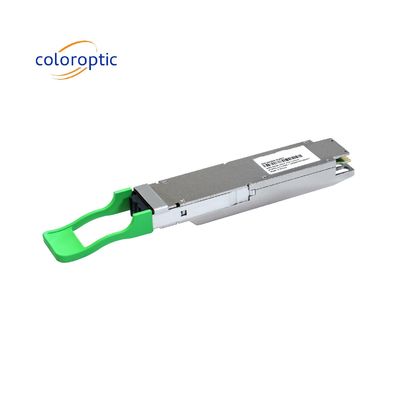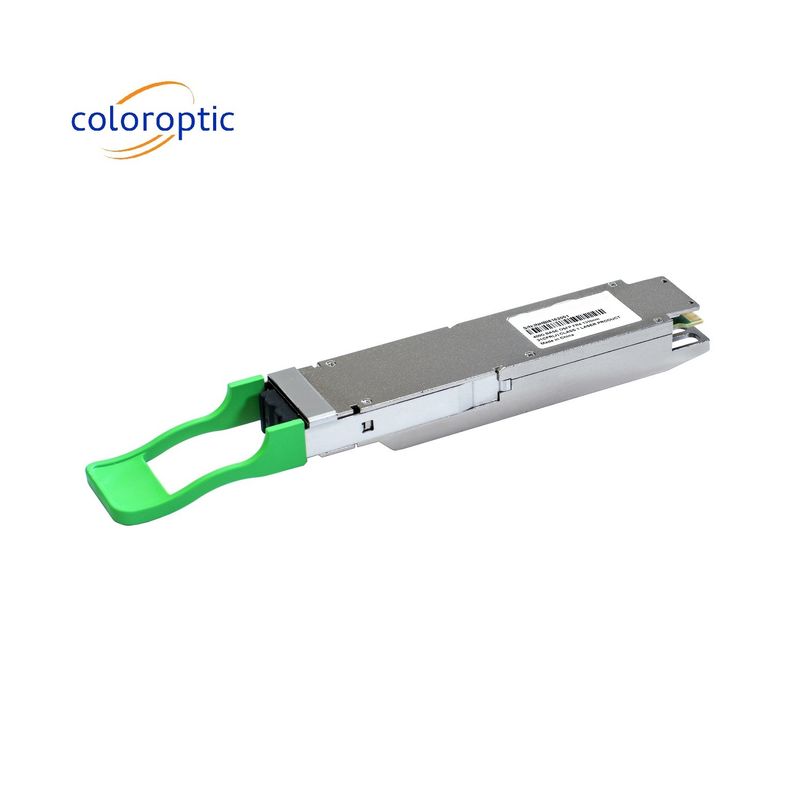400G OSFP FR4 Transceiver 2km 1310nm CMIS 4.0 With MPO-12 Connector
Product Details:
| Place of Origin: | China |
| Brand Name: | ColorOptic |
| Certification: | ROHS, CE |
| Model Number: | CO-OS4H13F4 |
Payment & Shipping Terms:
| Minimum Order Quantity: | 2 |
|---|---|
| Price: | Negotiable |
| Packaging Details: | Seal trays and cartons |
| Delivery Time: | 5 days |
| Payment Terms: | L/C, T/T |
| Supply Ability: | 1000 pieces/month |
|
Detail Information |
|||
| Connector: | MPO-12/16 | Operating Temperature: | 0℃ To 70℃ |
|---|---|---|---|
| Relative Humidity: | 5% To 95% | Wavelength: | 130nm |
| Dimension: | 70mm*42mm*18mm | Transmission Distance: | 2Km |
| Power Consumption: | 2.5W | Media Type: | Single-mode |
| Highlight: | 400G QSFP FR4,OSFP Transceiver 1310nm,OSFP Transceiver CMIS 4.0 |
||
Product Description
OSFP 400G 4*100G FR4 2km 1310nm Transceiver With MPO-12 Connector Compliant To CMIS 4.0
Product Description:
The ColorOptic OSFP (Octal Small Form-factor Pluggable) is a high-speed optical transceiver module used for data communication applications. The OSFP 400G refers to the 400 Gigabit per second (Gbps) version of the OSFP module.
The "4*100G FR4" specification indicates that the OSFP 400G module supports four separate 100 Gigabit Ethernet (100G) channels, using the FR4 (Fiber Reinforced) optical interface. Each channel operates at a data rate of 100 Gbps and utilizes four wavelengths of light for transmission over single-mode fiber optic cables.
.
Features:
- Product Name: OSFP Module
- Transmission Distance: 300m
- Fiber Type: Multi-mode
- Storage Temperature: -40℃ To 85℃
- Relative Humidity: 5% To 95%
- Wavelength: 850nm
- Supporting OSFP switch, Infiniband and ethernet
Technical Parameters
| Parameter | Symbol | Min | Typical | Max | Units | No |
| Operating Case Temperature | TOP | 0 | 70 | degC | ||
| Link Distance | D | 0.002 | 2 | km | ||
| Power Consumption | 10 | W | ||||
| Center Wavelength | L0 | 1264.5 | 1271 | 1277.5 | nm | |
| L1 | 1284.5 | 1291 | 1297.7 | nm | ||
| L2 | 1304.5 | 1311 | 1317.5 | nm | ||
| L3 | 1324.5 | 1331 | 1337.5 | nm | ||
| Average Launch Power,each Lane | PAVG | -3.2 | 4.4 | dBm | ||
| OMA, each Lane | POMA | -0.2 | 3.7 | dBm | ||
| Average Receive Power,each Lane | -7.2 | 4.4 | dBm | |||
| Receive Power(OMA),each Lane | 3.7 | |||||
| Receiver Sensitivity(OMA) | SEN | max(-4.6,SECQ-6.0) | dBm |
Applications:
ColorOptic OSFP 400G 4*100G FR4 module can be used in various high-speed data communication applications, such as data centers, cloud computing, high-performance computing, and telecommunications.
In data centers and cloud computing environments, the module can be used to connect servers, switches, and routers at high speeds over long distances. The 400G capacity and four independent channels make it ideal for handling large amounts of data traffic.
In high-performance computing applications, the module can be used to interconnect supercomputers, data storage systems, and other high-speed computing devices. The high-speed data transfer capabilities of the module enable faster processing and analysis of large datasets.
In telecommunications applications, the module can be used to support high-speed data transmission over long distances. The four independent channels can be used to provide redundancy and failover capabilities to ensure reliable data transfer.
Customization:
The customization features of the OSFP 400G 4*100G FR4 module may vary depending on the specific manufacturer and model. However, some potential customization options could include:
- Wavelength Configuration: The module may offer the flexibility to configure the wavelengths used for each of the four 100G channels. This can be useful in optimizing the transmission performance based on the specific network requirements.
- Power Budget Adjustment: The module may allow adjustment of the power budget, which refers to the maximum allowable power loss in the optical link. This customization feature can be helpful in optimizing the link performance based on the distance and fiber type used.
- Digital Diagnostic Monitoring: The module may provide digital diagnostic monitoring capabilities, allowing real-time monitoring of various parameters such as temperature, voltage, and optical power levels. This feature can aid in troubleshooting and performance optimization.
- Firmware Upgrades: Manufacturers may provide firmware upgrades for the module, enabling compatibility with future network standards or adding new features and functionality.





